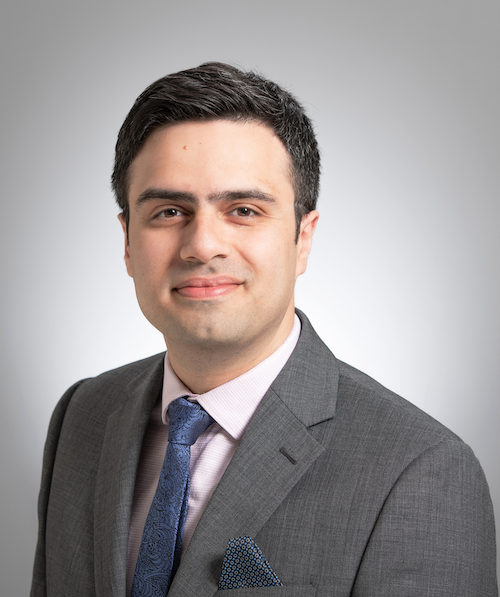S.M. Qasim Hussaini, M.D., assistant professor of Medicine in the Division of Hematology and Oncology and health systems researcher at the O'Neal Comprehensive Cancer Center, is the latest winner of the Heersink School of Medicine’s Featured Discovery. This honor acknowledges and celebrates the important research made by Heersink’s faculty members.  S.M. Qasim Hussaini, M.D.
S.M. Qasim Hussaini, M.D.
The study, “Association of Historical Housing Discrimination and Colon Cancer Treatment and Outcomes in the United States,” was published in JCO Oncology Practice.
Hussaini and his team “investigated the association between historical housing discrimination and contemporary diagnosis, treatment, and survival outcomes in colon cancer – a leading cause of cancer deaths amenable to early detection and treatment”. In the 1930s, American neighborhoods were subdivided into four risk-based rankings (A-best neighborhood, B-still desirable, C- in decline, and D-hazardous and mapped in red) for mortgage and approvals and denials.
“We undertook a nationwide study of the association between residence in areas targeted by institutional racism in the 1930s, which created a platform for systemic disinvestment, and present-day consequences in access to quality colon cancer care and outcomes,” said Hussaini.
The patients in their study who lived in Home Owner’s Loan Corporation (HOLC) D “had higher odds of being diagnosed with a later stage cancer (like stage III or IV), as well as higher odds of non-guideline concordant colon cancer care with longer time to chemotherapy initiation.”
According to Hussaini’s research, out of the 98,335 patients who were newly diagnosed with colon cancer, individuals in the HOLC C and D also had lower survival compared to HOLC A. Hussaini led this research in collaboration with the American Cancer Society.
Their research concluded by emphasizing the importance of screening for key social determinants of health such as housing, mortgage regulation within state and federal levels, and enforcing fair housing practices, as a way of improving equity in cancer care. “Findings underscore the long shadow of institutional racism through state- and federal-level discriminatory practices in shaping access to high-quality care and better outcomes for colon cancer, which is amenable to early detection and treatment,” said Hussaini.
The Heersink communications team met with Dr. Hussaini to learn more and spread awareness about the study and the Heersink School of Medicine.
Q: What compelled you to pursue this research?
I believe housing to be a master social determinant of health. Not only is housing the single biggest monthly expense for most American families, but where you live in this country today is closely tied to many things – one’s education, access to transportation, groceries, clean environment, social mobility, job, and ultimately health care as well. Few studies have examined the critical role of historical housing discrimination, which resulted in decades of underinvestment and neglect in major metropolitan cities across the US, in impacting cancer care. Our goal was to do exactly this and put together the first study that examines the role of housing discrimination comprehensively across the cancer continuum, from diagnosis to treatment to survival. Recognizing social and environmental conditions imposed on individuals as a fundamental cause of health inequities is the first step in implementing structural and policy-level solutions to impact cancer equity.
Q: How do you feel your research will impact the science community?
It is one of the earliest studies to empirically investigate housing discrimination as an important factor contributing to health outcomes in specific communities and demonstrates new tools in spatial analytics that can further our understanding of place-based discrimination and how the field approaches similar questions in the future. It also uniquely combines the country’s largest cancer registry with historical maps from the New Deal era. Real-world implications of such work extend to how we consider building provider, institutional, and policy-level interventions to tackle it.
Q: What is your research’s relevance to human disease?
My research specifically focuses on health systems, law, and policy as it pertains to oncologic care. In particular, my current work examines disparities in neighborhood and social context, financial and economic instability, and how local, state, and federal-level policy could be effectively utilized to improve care access and delivery.
Q: What made you come to UAB?
It was a mix of personal and professional reasons. My wife and I are both clinicians–I am a medical oncologist and my wife a neurologist–and we are new parents, so we wanted to be close to family in the South and live a more laid-back life than the one we were used to on the East Coast. The O’Neal Comprehensive Cancer Center of UAB where I practice is also the only NCI-Designated Comprehensive Cancer Center providing patient care to Alabama, and the four state region comprising of Alabama, Mississippi, Louisiana, and Arkansas. It is definitely exciting to be part of the journey of our cancer center as it expands and provides much-needed care to the local community. This also ties directly into my research work. I knew UAB would be the right place for me to take the next steps in growing my research group in new directions.
Q: What do you find makes the science community here unique?
Since our move to UAB only four months ago, I am learning that not only is UAB a phenomenal medical center, but it is also a very collaborative environment especially conducive to science. There are groups engaged in some stellar research work across the schools of Medicine, Public Health, Business, and the College of Arts and Sciences that I actively collaborate with. There is access to rich resources, databases, and tools to conduct science too. Finally, I will say UAB is very engaged in directly translating research findings into interventions in the local community of Birmingham as well as the larger catchment area of Alabama.